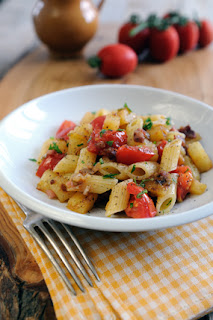Spring has arrived. All the signs are here. The market stalls are filled with spring vegetables, the trees are budding and the sun is beaming. Carlo, my neighbour, said it’s time to get to work in the orto – vegetable patch. I dusted down my old boots and went to the consorzio this morning and bought seeds. And if you need further evidence of the changing season, the odd Italian is even braving the outdoors without a jacket – although not before midday.
Yesterday at the market the asparagus, peas, spring onions and fine green beans were stacked alongside the last of the winter vegetables. The first spring vegetables are always popular and trade was brisk. The lady in front of me was buying long thin asparagus shoots. She had a fistful of asparagus in one hand, a bunch of spring onions in the other, and was waving her arms excitedly trying to catch the farmer’s attention – I figured she was planning a risotto. Peas were selling well too. With a nod of approval from the farmer, I opened a pod. They were small, sweet and tender – perfect for what I had in mind.
Pasta salad is hugely popular in Italy
The only real sticking point – and, believe it or not, a matter of some considerable debate among Italians – is how to cool the pasta after cooking without destroying its texture. The traditional method is to pour a glass of cold water into the pot once the pasta is al dente to stop it cooking and then drain and rinse under cold water. However, many Italians will tell you that by stopping the cooking in this way the pasta absorbs too much water and can become gluey (or soggy). They have a point. A better way, it is claimed, is to begin by rinsing the uncooked pasta under water to remove some of the starch. It should then be boiled in plenty of salted water and drained when just al dente. To finish, the pasta should be tossed in a couple of tablespoons of extra virgin olive oil and laid out onto a cold steel or aluminium tray or surface. As the pasta cools it should be moved every so often to prevent sticking and to speed up the cooling process. Admittedly, this is a somewhat laborious procedure but, take my word for it, it does help to improve the quality of the finished dish.
Recipe
Spring Vegetable Pasta Salad
Insalata di pasta con verdure primaverile
Serves 4
Preparation time: 15 minutes
Cooking time: 30 minutes
300g short pasta such as fusilli or penne
200g shelled fresh peas
150g fine green beans
200g scamorza cheese, cut into cubes
150g black olives
250g baby cherry tomatoes
Extra virgin olive oil
Bunch of fresh basil
1 Tablespoon finely chopped parsley
Salt & freshly ground black pepper
Bring a large pan of salted water to the boil and add the pasta. Cook the pasta until just al dente and drain. Place the pasta back into the pot and add a few tablespoons of extra virgin oil. Tip the pasta onto a metal tray and allow to cool. Whilst the pasta is cooling, cook the green beans in salted water until tender. Two minutes before they are cooked add the peas. Drain and cool.
To assemble the salad, place the pasta in a large bowl. Add the tomatoes, cut into quarters, the olives, peas, chopped green beans and the scamorza cheese. Season generously with salt and pepper and dress with a few tablespoons of extra virgin olive oil, chopped parsley and basil leaves.












